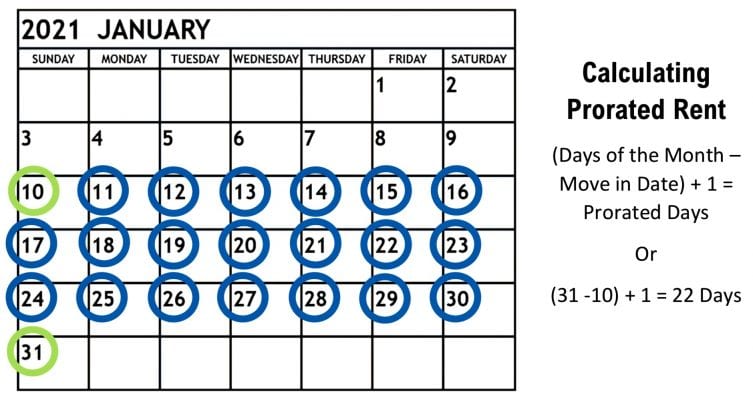
In a perfect world, every tenant would move in on the first and out on the last day of the month. However, the reality is never perfect. As a matter of fact, moving in after the first is very common throughout the rental industry. So, when the lease begins on any day other than the first, tenants may not need to pay the full months’ rent. Instead, this reduced amount is known as prorated rent. While it may require some calculation, the process is quite simple. In fact, landlords’ calculations are simpler than ever, thanks to sites that offer a free online prorated rent calculator. Continue reading below as we explain the meaning of this process and various ways to calculate prorated rent.
What is Prorated Rent?
Prorated rent comes into play when a tenant needs to move in after the beginning of the month or move out before the end of the month. Also known as “pro-rata” rent, the definition indicates that rent due is calculated proportionately. In short, tenants pay rent based on the monthly rate, but only for the days, they will occupy the unit. For example, if a tenant’s lease begins on February 10th, they only owe rent for the 10th through the 28th. This is in contrast to a lease beginning on the first in which they would be responsible for the entire month’s rent.

Are Landlords Required to Prorate Rent?
It is important to note that landlords do not have to prorate the rent unless the lease or local law requires it. Generally, in cases where the law or lease does not dictate the practice, prorating rent is seen as a professional goodwill gesture. So, as a landlord, having clear cut policies is crucial to preventing confusion or disputes. We recommend the following –
- Address Prorate Practices in the Lease – Incorporating a prorate clause into the lease is the best way for landlords and tenants to get on the same page. Thus, avoiding surprises or questions down the road. The lease will state exactly what the tenant owns based on when they move in, whether you choose to prorate or not. Remember to check your figures using an online prorated rent calculator or trusted formula. However, if you opt not to collect prorated rent, make sure this decision complies with local law.
- Establish Prorate Policies – Life happens! Sometimes a tenant’s lease begins on the first, but their move in is delayed through no fault of the landlord. Therefore, in these instances, a landlord is not expected to prorate the rent. However, it is a good idea to put this in writing. Another instance of debate concerns prorated rent at move out; some landlords accept it, some do not. Either way, the tenant must be aware of your stance from the start.
Ways to Calculate Prorated Rent
If you decide using proportionate rent is the way to go, you will find there are few simple steps to calculate prorated rent. Take a look at the formulas below or for hassle-free calculations, check out this free online prorated rent calculator from TurboTenant!
Step #1 – Calculate the Daily Rental Rate
Figuring out the daily rental rate is the first step to determining the total portion of rent. As a landlord, you will want to select the option for calculating daily rent and stick with it to ensure consistency. That said, the ways to calculate prorated rent by the day are below. For this example, we will assume the rental amount is $1200 per month.

- Days in the Year – The fairest and exact calculation uses the days in the entire year. Therefore, first, determine the yearly rent by multiplying the monthly rate by 12. Then, divide the amount by the days in a year, and do not forget leap years! So, for this example, the rate would be (1200×12)/365 or $39.45 per day.
- Number of Days in the Current Month – Additional ways to calculate prorated rent include using the individual month instead of the year. However, keep in mind that the rate could be more or less depending on the month a tenant moves in. For this example, let’s assume there are 31 days in the month. So, take the monthly rate and divide it by 31, which would equal $38.71 per day.
- Average Days in a Month – This method allows landlords to average out the total days in a month throughout the year. Therefore, the average number of days in a month equals 30.42. Thus, using this method, the daily rent would be (1200/30.42) or $39.45.
- Use a Banker’s Month – A banker’s month is recognized as 30 days. So, this method instructs landlords to divide the rental rate by 30 regardless of what month the tenant moves in. For example, (1200/30) equals $40.00 as a daily rate.
Step #2 – Calculating the Prorated Portion
Now that the daily rate is ready to go, the next step is calculating the month’s prorated rent portion. This, too, is a simple calculation involving subtraction to figure out the number of days a tenant needs to pay. For this example, we will assume the tenant is moving in on the 10th of a 31 day month. So, follow along below –
How to Calculate Prorated Days of the Month
To calculate prorate days of the month the tenant is responsible for, use the formula –
(Days of the Month – Move-in Date) + 1 = Prorated Days
Or for this example, the calculation would be (31 -10) + 1 = 22 Prorated Days

From here, it is a matter of simply multiplying the daily rate you use by the number of prorated days the tenant is required to pay. Therefore, to illustrate the example, check out the figures below –
- Days in the Year – 22 Days x $39.45 per day = $867.90
- Number of Days in the Current Month – 22 Days x $38.71 per day = $851.62
- Average Days in a Month – 22 Days x $39.45 per day = $867.90
- Use a Banker’s Month – 22 Days x $40.00 per day = $880.00
When Does a Tenant Pay Prorate Rent?
As a landlord, laying out policies surrounding the payment of prorated rent is critical. Part of that policy should include when the prorated amount is collected. Moving is a costly process for tenants, and they deserve ample time to budget accordingly. That said, some landlords require the first month’s rent in full regardless of when the tenant moves in. For instance, if the landlord uses a realtor or professional management firm to fill the vacant unit, the first months’ rent is typically paid as a leasing fee. Therefore, if that is the case, let’s look at a sample tenant payment schedule based on our example so far –
- January – Move-in January 10th with Security Deposit and 1st Months’ Rent ($1200) Due in Full
- February – Prorated Rent Amount from January is Due
- March – $1200 Rent Due
- April – $1200 Rent Due … and so on

The key to success here is communication. That said, review the various ways to calculate prorated rent and decide which is best for you and your investment property. Afterward, clearly identify and communicate your policies both in writing and verbally to your tenant, so everyone is on the same page. Additionally, once their application has been approved, email or send them a list of all charges they can anticipate being due upon move-in and answer any questions they may have. This is the first best step to developing a great landlord-tenant relationship.
Conclusion
As with every aspect of owning a rental property investment, the decisions you make set the tone for the lease duration and, ultimately, your success. So, when it comes to finding ways to calculate prorated rent, stick to the tried-and-true formulas. Is leasing becoming a tedious and overwhelming task that gobbles up time throughout your day?
Why not enlist the services of a quality rental property management firm to help with your investment property? Our dedicated leasing professionals at Bay Property Management Group handle every step in renting your unit while helping tenants navigate our legal lease documents. So, if you want to save personal time while renting your property faster, give us a call today!
